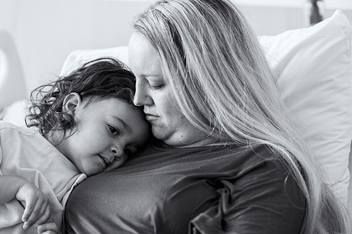PSARVUP for Cloacal Malformation
When a baby girl’s anus, urethra and vagina do not separate in utero, she is born with a cloacal malformation. With cloacal malformation, which is sometimes called persistent cloaca, the baby typically has just one opening on her perineum. The perineum is the area between and the anus and the vulva.
An operation called PSARVUP can correct the cloacal malformation. PSARVUP stands for posterior sagittal anorectal vaginal urethralplasty. At Nationwide Children’s Hospital, our specialists in colorectal surgery, gynecology and urology in the Center for Colorectal and Pelvic Reconstruction are experts in this advanced procedure. We take a patient-centered approach so families understand this treatment option every step of the way.
What Is PSARVUP Surgery?
While in her mother’s womb, a baby girl develops the cloaca. The cloaca is the common passageway that develops into three passages for feces, urine and reproduction. During normal development, the cloaca should divide into three areas: the bladder, genitalia and rectum. When this does not occur, it must be corrected surgically. PSARVUP is the name of the surgery. The surgical team usually performs PSARVUP when the baby is between 6 and 12 months old.
Meet Dr. Richard Wood

Dr. Richard Wood serves as chief of our Center for Colorectal and Pelvic Reconstruction, one of the first centers in the world to formally integrate all specialties involved in providing complete care of the colon and rectum in kids.
What Happens Before Surgery?
Prior to PSARVUP, the Nationwide Children’s CCPR team will do an exam of the perineum. The purpose of this exam is to diagnose the cloacal malformation. The doctor will then do a screening to identify any other malformations that may be life-threatening. A surgeon will also perform a colostomy to create a passageway for feces.
Additionally, the doctor will drain any fluid that has built up in the vagina causing it to enlarge, which is known as hydrocolpos. In most cases, the fluid can be drained regularly with a catheter. Providers at Nationwide Children’s look to this method as a first option because it is less invasive and has been shown to be as effective as a vaginostomy in regard to the kidneys . In some cases, however, a vaginostomy may be required.
If a vaginostomy is required, our medical team will do a more thorough examination while the baby is under anesthesia.
Prior to the main reconstruction, all cloaca patient will undergo an in-depth examination under anesthesia. This exam includes:
- A cystoscopy to see the bladder and the urethra
- A vaginoscopy to examine the vagina
- A review of the gastrointestinal anatomy
The surgical team will also place catheters into the different tracts. Following the catheter placement, the baby will visit interventional radiology for a three-dimensional scan called a cloacagram. This 3D reconstructive imaging has been shown by researchers at Nationwide Children’s and other centers throughout the U.S. to be more accurate than measuring with scopes. During this scan, we further examine the anatomy and plan for reconstructive surgery.
The team will take several other factors into account to plan the baby’s PSARVUP, including:
- The length of the baby’s common channel, or the tube leading out of the body.
- Whether or not the baby has uterine didelphys, which is where a baby has more than one uterus, cervix and possibly vagina. About 45% of babies with persistent cloaca also have uterine didelphys.
- The length of the urethra.
- The ability to reach the rectum from below.
What Happens During Surgery?
Our expert surgeons will perform PSARVUP surgery based on the length of the common channel and urethra above the common channel. The surgeons separate the rectum, urethra and vagina. This creates three openings: urethra, vagina and anus.
There are two ways surgeons accomplish this: total urogenital mobilization (TUM) and a urogenital separation. The method used depends on the baby’s individual circumstances. The surgical team will determine which approach is best for each patient. This will optimize the functional outcome and minimize surgical risk for the baby. The key to making these decisions is high-quality imaging and endoscopy, and a collaborative approach. The Center for Colorectal and Pelvic Reconstruction has pioneered this approach in a large number of patients with excellent results.
What Happens After Surgery?
The child will recover for several day in the hospital after surgery. Most patients will be discharged with a catheter in the bladder to drain urine while they are healing.
About one month after surgery, the baby will return to the hospital for a follow-up appointment. During this exam, the doctor will evaluate the progress of the baby’s healing. The doctors will remove those tubes a few weeks later if the healing is found to be adequate. After removing the tubes, the doctor will continue to ensure that the baby is feeling well and draining urine properly.
Several months after the PSARVUP, the baby’s colorectal surgeon will surgically close the colostomy. After this procedure, the baby will be able to have normal bowel movements through the anus. The urodynamics which are initially done prior to surgery to evaluate bladder function are repeated 3 months after the reconstructive operation.
What Are the Risks Involved With PSARVUP?
Like with any surgery, PSARVUP has a certain amount of risk involved. These include bleeding, infection, a negative reaction to anesthesia or an unusual amount of pain. A few clues that it is time to call a doctor include excessive crying, high fever or an inability to pass feces or urine. CCPR has a surgeon on call 24 hours a day all year round.
What Does Long-Term Recovery Look Like?
Experts at Nationwide Children’s partner with a baby’s family from childhood through adulthood. The Center for Colorectal and Pelvic Reconstruction is the only center in the United States that offers this comprehensive level of care for cloaca malformation. When the baby is ready to potty train, we provide support and assistance. A bowel management program, clean intermittent catheterization (CIC), enema program and reconstructive surgery of the urinary tract are additional tools available to families.
We also offer psychological support all the way to adulthood. During puberty, we check the workings of the gynecological system, urinary tract and bowels once again. If reconstructive surgery is required during any stage, our team guides the family through next steps.



